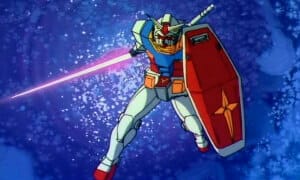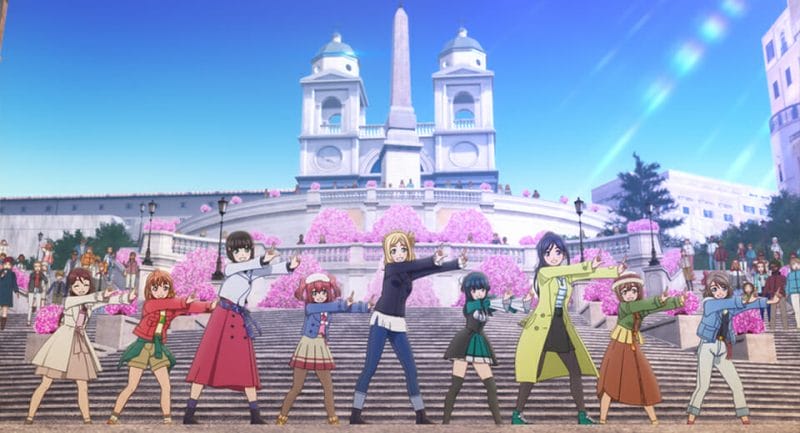US Distributor: Right Stuf International
Production Studio: Sunrise
Was this provided by the publisher? Yes
More Info: Anime News Network
 Note: This review contains spoilers for the original Mobile Suit Gundam, as well as the compilation films. Reader discretion is advised. Because all three films were released in one set, this review will contain reviews for all three films.
Note: This review contains spoilers for the original Mobile Suit Gundam, as well as the compilation films. Reader discretion is advised. Because all three films were released in one set, this review will contain reviews for all three films.
In 1981, Mobile Suit Gundam creator Yoshiyuki Tomino returned to the title that would go on to spark a media juggernaut. The first Gundam anime saw a surprising degree of popularity in syndication on Japanese TV, which prompted the production of three films that would retell its story.
One of the most notable changes for the films is the new animation, which was used in conjunction with the original TV footage. As the films progressed new animation was used more frequently, to the point that 70% of the final film was composed of new animation. In particular, the new footage features several redone battles from the TV series, allowing these epic clashes to get the attention they deserve. The overall experience in these interstellar skirmishes sees a noticeable bump in quality, as they’re presented as more fluid and detailed than they were the original show.
As the new footage was produced just a few years after the original series, there is a strong consistency between the two works, and the old animation meshes well with the new. In general, the new animation has aged well over the years, and still looks great by today’s standard.
That said, there are some very real issues that arise from mixing old animation with new. The biggest of these are continuity issues. For example, the fact that old and new footage is spliced together often leads to characters switching between rank insignias over the course of a scene. The G-Fighter, which was completely removed from the films, also shows up twice due to this fusion of old and new. It’s not a major issue, but it is ever-present throughout the three films.
Mobile Suit Gundam
The first film takes on the Herculean task of covering the first thirteen episodes of the Mobile Suit Gundam TV series in a little over two hours. Is it a smooth transition?
Not quite.
Because material was condensed to fit into the run time, footage was removed, and certain story points were condensed and combined with other parts of the story to make everything work. As an unfortunate side effect, several major events saw their overall impact softened in transition.For example, a majority of the events from episodes 3 and 4 of the TV series were removed, meaning that Amuro only sees three battles instead of five by the time the White Base begins reëntry into Earth’s orbit. When White Base goes into battle shortly thereafter, the impact of Amuro’s unwillingness to enter the fray is softened, as he hadn’t been exposed to the horrors of eight full sorties on the battlefield.
The format also sees key moments of foreshadowing removed entirely, such as Char’s willingness to betray Garma or his thirst for revenge against the Zabi family. In the ninth episode of the TV series, Char rigs a communication cable so that Garma can’t be heard by the Gaw. Since this doesn’t occur in the film, his double crossing of Garma doesn’t receive the build up it should have gotten.
Possibly the biggest alteration from the TV series to the movie, though, is the fact that the issue of Newtypes is introduced far sooner than its broadcast counterpart.
Overall, the film follows a slow, trundling pace, though it’s generally by necessity. The feature sets the stage for the rest of the trilogy that lay ahead.
Mobile Suit Gundam II: Soldiers of Sorrow
The second movie covers episodes sixteen to thirty, in addition to the early moments of the thirty-first chapter. Much like its predecessor, Soldiers of Sorrow suffers from a challenging transition. It runs into the same issues that arise from cramming fifteen episodes of content into just over two hours run time. And, much like the first film, this mean that there are sacrifices to overall impact and timing of key events. Amuro’s desertion still occurs in the film, but instead of having this occur over two episodes and allowing his arrogance to swell and attack a worthless mining base, his abandonment generally feels impotent and weak. That’s to say nothing of the shortened character arc for Mirai. Bright’s exhaustion and Mirai becoming the temporary captain of the White Base is completely removed.
The biggest change in transition to film, though, has to be Operation Odessa. In the TV series, the White Base is part of the battle. In Soliders of Sorrow, though, they are not. Instead, the crew deals with Hamon and her effort to destroy the White Base.
The editing in this installment isn’t quite as smooth as its predecessor’s. There are moments where characters are introduced, but then don’t show up again until much later, for example. A better eye for editing would have had these characters make themselves known when they needed to appear.
Mobile Suit Gundam III: Encounters In Space
The final film in the trilogy is easily the best of the bunch, and boasts a pace that’s brisk without feeling rushed. That said, there are still a few minor quirks that stand out with the film. Due to the shorter run time of the trilogy, several mobile armors that appeared throughout the TV series were removed outright. Because of this, we don’t get to see the evolution of Zeon, as they try different approaches to gain an advantage in the war. Likewise, the removal of the Gyan mobile suit essentially means that M’Quve is robbed of his death scene, as he disappears toward the end of the feature.
Likewise, there is a bit of rearrangement in the plot, as the films see the White Base visiting the Texas Colony before going to the Battle of Solomon instead of the other way around in the TV series.
The most important addition, though, involves the end of the film. In the end of the TV series, it’s left ambiguous as to whether or not Char had survived the final battle. Encounters In Space destroys this ambiguity, as it clearly shows that he had survived the final battle by showing his silhouette on a ship during the final credits.
In the end, though, the real question is “which version of Mobile Suit Gundam should you watch?” And, really, that depends. If your time is limited, then watching the movie is your best option. If you have time to commit to a TV series, though, then watch the original show.
Personally, I would go with the TV series over the movie version. The films removes a few too many parts of the story, which ends up culling important character development arcs. That said, the Mobile Suit Gundam film trilogy isn’t a bad set of films. Every fan of the Gundam franchise should see this trilogy at least once in their lifetime.












